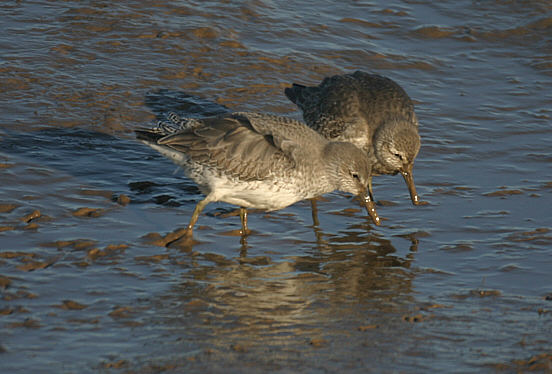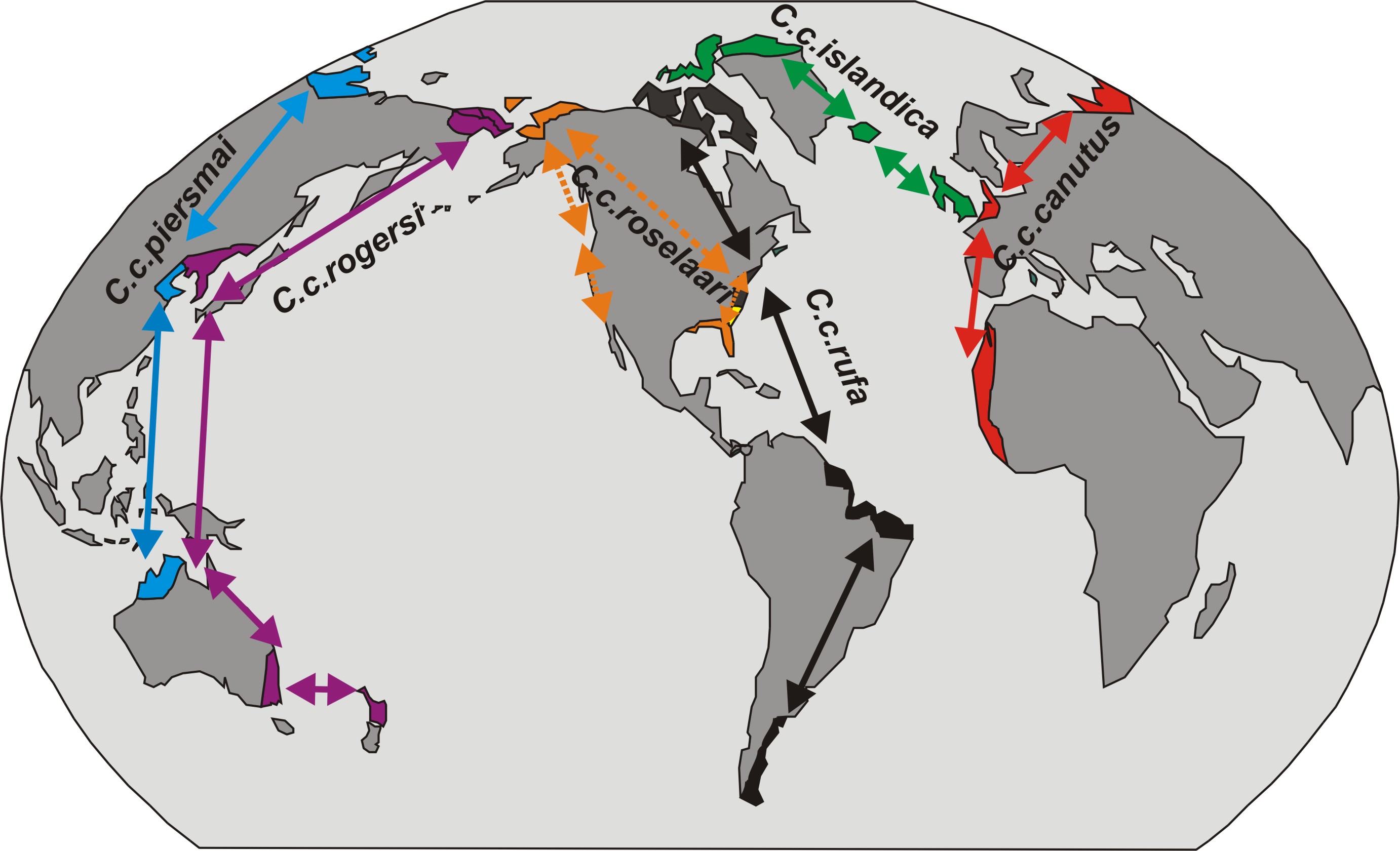- Red Knot
Taxobox
name = Red Knot
status = LC | status_system = IUCN3.1
status_ref ={IUCN2006|assessors=BirdLife International|year=2004|id=49073|title=Calidris canutus|downloaded=12 May 2006 Database entry includes justification for why this species is of least concern]

image_caption = winter plumage
regnum =Animal ia
phylum = Chordata
classis = Aves
ordo =Charadriiformes
familia =Scolopacidae
genus = "Calidris"
species = "C. canutus"
binomial = "Calidris canutus"
binomial_authority = (Linnaeus,1758 )
range_
range_map_caption = Distribution and migration routes of the six subspecies of the Red Knot
synonyms ="Tringa canutus"The Red Knot, "Calidris canutus" (just Knot in
Europe ), is a medium sized shorebird which breeds intundra and theArctic Cordillera in the far north ofCanada ,Europe , andRussia .Birds bred in north America migrate to coastal areas in
Europe andSouth America , while birds bred inEurope migrate toAfrica ,Papua New Guinea ,Australia andNew Zealand (see distribution map). This species forms enormous flocks in winter.Taxonomy
This species was first described by Linnaeus in his "Systema naturae" in 1758 as "Tringa canutus". [la icon cite book | last=Linnaeus | first=C | authorlink=Carolus Linnaeus | title=Systema naturae per regna tria naturae, secundum classes, ordines, genera, species, cum characteribus, differentiis, synonymis, locis. Tomus I. Editio decima, reformata. | publisher=Holmiae. (Laurentii Salvii). | date=1758| quote = T. roftro laevi, pedibus cinerascentibus, remigibus primoribus ferratis. |pages=149] It is sometimes said that the Red Knot gets its name from King Cnut, but there is no factual basis for this story. A more likely etymology is that the name is onomatopoeic, based on the bird's grunting call note.
There are six subspecies, in order of size;
*"C. c. roselaari" (largest)
*"C. c. rufa"
*"C. c. canutus"
*"C. c. islandica"
*"C. c. rogersi"
*"C. c. piersmai" (smallest)Behaviour
The Red Knot nests on the ground, near water, and usually inland. The female lays 3 to 4 eggs in a shallow scrape lined with leaves and
moss . Both parents incubate the eggs, but the female leaves before the young fledge. After the young have fledged the male begins his migration south and the young make their first migration on their own.On the breeding grounds, Knots eat mostly
spider s,arthropod s, and larvae obtained by surface pecking, and on the wintering grounds they eat a variety of hard-shelled prey such as bivalves,gastropod s and smallcrab s that are ingested whole and crushed by a muscular stomach.Description
An
adult Red Knot is 23-26 cm long with a 47-53 cmwingspan . It has short dark legs and a medium thin dark bill. The body is mottled grey on top with a cinnamon face, throat and breast and light-coloured rear belly. In winter theplumage becomes uniformly pale grey. "canutus, islandica" and "piersmai" are the “darker” subspecies. "rogersi" has a lighter belly than either "roselaari" or "piersmai", and "rufa" is the lightest in overall plumage.The weight varies with subspecies, but is between 100 and 200 g. Red Knots can double their weight prior to migration.7676786
tatus
The Red Knot has an extensive range, estimated at 0.1–1.0 million square kilometres (0.04–0.38 million square miles), and a large population of about 1.1 million individuals. The species is not believed to approach the thresholds for the population decline criterion of the IUCN Red List (i.e., declining more than 30% in ten years or three generations), and is therefore evaluated as
Least Concern ."C. c. canutus" and "C. c. islandica" are among the subspecies to which the "Agreement on the Conservation of African-Eurasian Migratory Waterbirds" (
AEWA ) applies.Threats to the American subspecies ("C. c. rufa")
Near the end of the 19th century, large numbers of Knot were shot for food during migration in
North America . More recently, the birds have become threatened as a result of extensive commercial harvesting ofhorseshoe crab s in Delaware Bay which began in the early 1990s. Delaware Bay is a critical stopover point during spring migration; the birds refuel by eating the eggs laid by these crabs, and with reduced numbers of horseshoe crabs living in the bay there are fewer eggs to feed on.In 2003, scientists projected that at their current rate of decline the American subspecies might go extinct as early as 2010. Several environmental groups have petitioned the U.S. government to list the birds as endangered, but thus far their requests have been denied. In New Jersey, state and local agencies are taking steps to protect these birds by limiting horseshoe crab harvesting and restricting beach access. In Delaware, a two-year ban on the harvesting of horseshoe crabs was enacted but struck down by a judge who cited insufficient evidence that the ban would help restore the Red Knot's numbers to justify the potential disruption to the fishing industry.
References
* "Shorebirds" by Hayman, Marchant and Prater ISBN 0-395-60237-8
* Baker, Allan J., et al. 2004 [http://www.pubmedcentral.nih.gov/picrender.fcgi?artid=1691665&blobtype=pdf Rapid Population Decline in Red Knots: Fitness Consequences of Decreased Refueling Rates and Late Arrival in Delaware Bay] , Proceedings of The Royal Society 271, 875-882.
* Piersma, T., de Goeij, T. P. & Tulp, I. 1993 An evaluation of intertidal feeding habitats from a shorebird perspective: towards relevant comparisons between temperate and tropical mudflats. Netherlands Journal of Sea Research 31, 503-512.
* Piersma, T., Dietz, M. W., Dekinga, A., Nebel, S., van Gils, J. A., Battley, P. F. & Spaans, B. 1999 Reversible size-changes in stomachs of shorebirds: when, to what extent, and why? Acta Ornithologia 34, 175-181.
* Tomkovich, P. S. 1992 An analysis of the geographic variability in knots Calidris canutus based on museum skins. Wader Study Group Bulletin 64 Supplement, 17-23.
* Tomkovich, P. S. 2001 A new subspecies of Red Knot Calidris canutus from the New Siberian Islands. Bulletin of the British Ornithologists Club 121, 257-263.
* Tulp, I., Schekkerman, H., Piersma, T., Jukema, J., de Goeij, P. & van de Kam, J. 1998 Breeding waders at Cape Sterlegova, northern Taimyr, in 1994. Zeist: WIWO - Report 61.External links
* [http://www.birds.cornell.edu/AllAboutBirds/BirdGuide/Red_Knot.html - Cornell Lab of Ornithology - Red Knot]
* [http://www.mbr-pwrc.usgs.gov/id/framlst/i2340id.html - USGS - Red Knot Information]
* [http://www.sdakotabirds.com/species/red_knot_info.htm - South Dakota Birds - Red Knot Information and Photos]
* [http://www.enature.com/fieldguides/detail.asp?recnum=BD0214 - eNature.com - Red Knot]
* [http://www.fws.gov/northeast/redknot/riverkeeper.pdf - Federal Wildlife Service - Petition to List the Red Knot (Caladris canutus rufa) as Endangered and Request for Emergency Listing under the Endangered Species Act]
* [http://www.delmarvanow.com/apps/pbcs.dll/article?AID=/20070608/NEWS01/70608047/1002 - delmarvanow.com - Horshoe Crab Ban Overturned]
* [http://www.state.nj.us/dep/fgw/ensp/about2k.htm In Search of the Red Knot-New Jersey Fish and Game] *
* [http://www.fws.gov/northeast/redknot/ US Fish and Wildlife Service]
* [http://shorebirdproject.blogspot.com/ The Shorebird Project]
* [http://www.state.nj.us/dep/fgw/ensp/redknot.htm Red Knot - An Imperiled Migratory Shorebird in New Jersey]
* [http://www.pbs.org/wnet/nature/crash/conservation.html - Why Save the Red Knot? Nature PBS]
Wikimedia Foundation. 2010.
